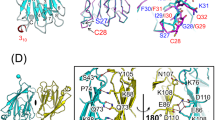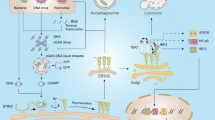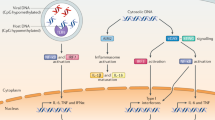Abstract
Replying to U. Nachbur, J. E. Vince, L. A. O'Reilly, A. Strasser & J. Silke Nature 488, 10.1038/nature11366 (2012).
Nucleotide-binding and oligomerization domain (NOD) receptors are cytosolic sensors of microbe-associated molecular patterns (MAMPs). Like other members of the BCL2 family of proteins (such as BCL2 and BCL-XL1), BID has a role in inflammation and innate immunity2,3. Its association with the NOD signallosome showed it to be an important player in the pathway. Furthermore, a recent report demonstrated unequivocal and direct binding of BID to purified NOD1 protein4. Although Nachbur et al.5 question whether BID is essential for NOD signalling, they show no clear evidence to the contrary. Instead, they provided three data sets, and an analysis of these data sets is presented in Fig. 1 and Appendix Fig. 1 (ref. 5). Although there was considerable variability in the results from these independently performed experiments (also apparent in the data presented in their Comment), overall the data support the findings in our Letter6 that BID contributes to the NOD-mediated response. A challenge to our conclusions was based on the claim that BID deficiency does not affect NOD signalling. Data in Appendix Fig. 1a and b (ref. 5) support our conclusions and show a role for BID in NF-κB activation (decreased p65 phosphorylation). By contrast, a third set of immunoblots shows the opposite effect, in which BID seems to be a negative regulator of NF-κB signalling (increased p65 phosphorylation in Bid−/− cells; Fig. 1 from ref. 5). The basis for these incoherent and non-reproducible results is unclear but suggests technical caveats. For instance, it is surprising to see p65 phosphorylation in Ripk2−/− cells (Fig. 1c in ref. 5).
This is a preview of subscription content, access via your institution
Access options
Subscribe to this journal
Receive 51 print issues and online access
$199.00 per year
only $3.90 per issue
Buy this article
- Purchase on Springer Link
- Instant access to full article PDF
Prices may be subject to local taxes which are calculated during checkout

Similar content being viewed by others
Change history
14 November 2012
Nature 488, E6–E8 (2012); doi:10.1038/nature11367 In our Reply to the Brief Communications Arising ‘Is BID required for NOD signalling?’ we made use of a figure generated by the authors of the Comment (Nature 488, E4–E6 (2012); doi:10.1038/nature11366) as part of the review process, in the bottom panel of our Fig.
References
Bruey, J. M. et al. Bcl-2 and Bcl-XL regulate proinflammatory caspase-1 activation by interaction with NALP1. Cell 129, 45–56 (2007)
Luo, W. et al. Bid mediates anti-apoptotic COX-2 induction through the IKKβ/NFκB pathway due to 5-MCDE exposure. Curr. Cancer Drug Targets 10, 96–106 (2010)
Yeretssian, G. et al. Non-apoptotic role of BID in inflammation and innate immunity. Nature 474, 96–99 (2011)
Askari, N. et al. Expression, purification, and characterization of recombinant NOD1 (NLRC1): A NLR family member. J. Biotechnol. 157, 75–81 (2012)
Nachbur, U., Vince, J. E., O’Reilly, L. A., Strasser, A. & Silke, J. Is BID required for NOD signalling? Nature 488, https://doi.org/10.1038/nature11366 (2012)
Yeretssian, G. et al. Non-apoptotic role of BID in inflammation and innate immunity. Nature 474, 96–99 (2011)
Author information
Authors and Affiliations
Corresponding author
PowerPoint slides
Rights and permissions
About this article
Cite this article
Yeretssian, G., Correa, R., Doiron, K. et al. Yeretssian et al. reply. Nature 488, E6–E8 (2012). https://doi.org/10.1038/nature11367
Published:
Issue Date:
DOI: https://doi.org/10.1038/nature11367
This article is cited by
-
NOD proteins: regulators of inflammation in health and disease
Nature Reviews Immunology (2014)
-
Correction: Corrigendum: Yeretssian et al. reply
Nature (2012)
Comments
By submitting a comment you agree to abide by our Terms and Community Guidelines. If you find something abusive or that does not comply with our terms or guidelines please flag it as inappropriate.



